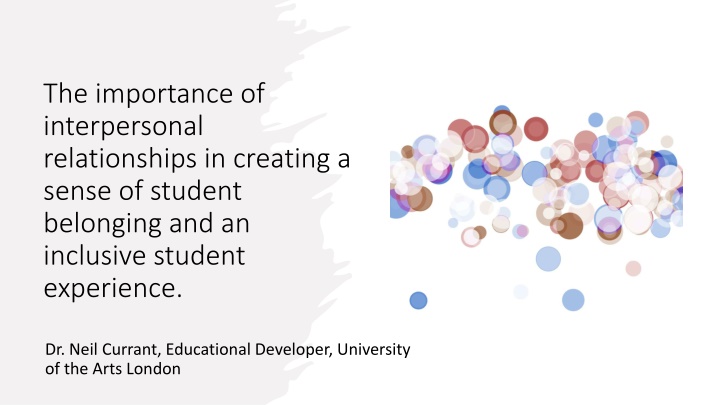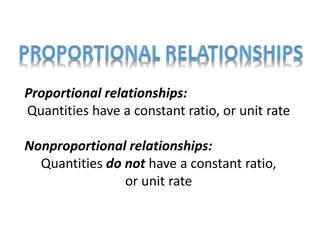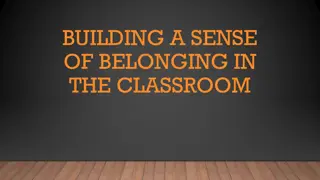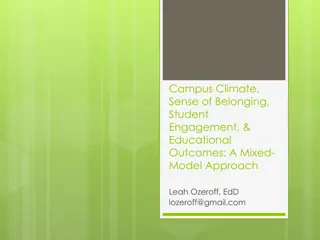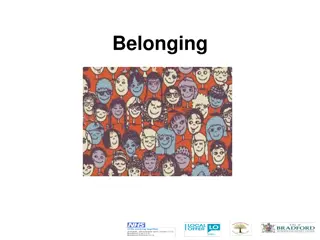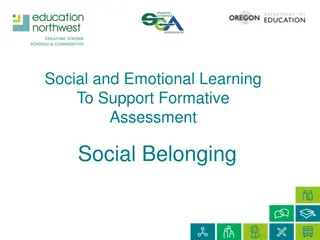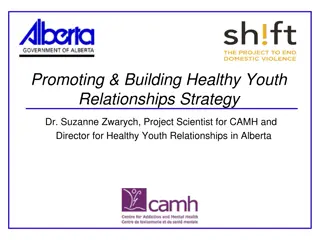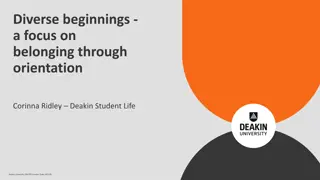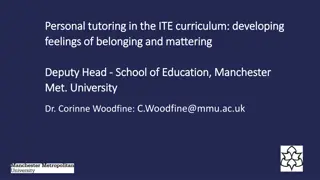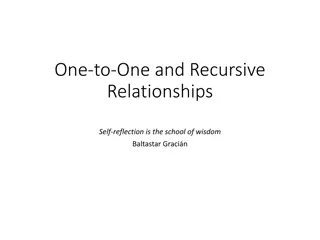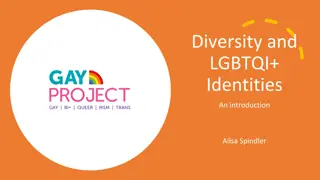Fostering Student Belonging through Relationships
This study delves into the significance of interpersonal relationships in enhancing student belonging and inclusivity. Dr. Neil Currant's research explores the role of academics in creating a sense of belonging, focusing on the experiences of British Asian and Black students. Concepts like 'a sense of fit' and 'contact' are discussed to understand how students establish connections within their academic environment.
Download Presentation

Please find below an Image/Link to download the presentation.
The content on the website is provided AS IS for your information and personal use only. It may not be sold, licensed, or shared on other websites without obtaining consent from the author.If you encounter any issues during the download, it is possible that the publisher has removed the file from their server.
You are allowed to download the files provided on this website for personal or commercial use, subject to the condition that they are used lawfully. All files are the property of their respective owners.
The content on the website is provided AS IS for your information and personal use only. It may not be sold, licensed, or shared on other websites without obtaining consent from the author.
E N D
Presentation Transcript
The importance of interpersonal relationships in creating a sense of student belonging and an inclusive student experience. Dr. Neil Currant, Educational Developer, University of the Arts London
Introduction Based on my doctoral research. Experiences of belonging for British Asian and Black students at a predominately white university. The impetus was addressing awarding gaps and trying to understand what might be behind them. Focus today - The academics role in belonging
Starting points What is belonging? Given a potential hostile campus climate, what do students do to create a sense of belonging?
Belonging Do we have a shared understanding of meaning? Belonging has both psychological and sociological definitions. I wanted a simple analytical, working definition I could use to understand students' experiences of belonging. 'Contact' & 'Sense of Fit' Belonging can derive from both or just one depending on the person.
A sense of Fit Whether the person feels that their characteristics are congruent with the wider group, system or environment (Hagerty et al. 1992). Common-identity groups (Prentice, Miller and Lightdale 1994). Characteristics / identity / shared interests etc. Fit is not the same as 'fitting in': where you have to change yourself to be welcomed (Strayhorn 2018) Ubuntu balance between individual and collective. My definition: How a person feels they fit into a social environment. One to many your relationship with the group.
Contact Close relationships and interpersonal attachments (Baumeister and Leary 1995, Fiske2004). Regular personal contact, affective concern and have some degree of stability over time. (Baumeister and Leary 1995) - personal tutor? Related concepts: Closeness (Goodenow 1993), Relatedness (Ryan & Deci 2000), connectedness (Strayhorn 2018). One to one aspect of belonging: building individual relationships / interactions.
Contact: Relationships / interactions Peer - peer interactions & staff student interactions For minoritised students peer interactions can be problematic and are usually cross-racial. Peer ignorance. Surprised such views occur in university: "that lack of understanding, it makes me feel like they haven t come across many people from another culture before in their past." (Saira) However, often have 'navigational' & 'resistant' capital (Yosso 2005) to cope with issues.
Student - Staff relationships Among many academic staff, there is an assumption that belonging is about peer relationships and extra-curricular activity (a sense of fit only) & not derived from student - staff relationships and relational approaches to pedagogy. But my research suggests that staff-student relationships (contact) is crucial for belonging. (e.g. Kandiko and Mewer 2013). I would go to one of those lecturers... Probably more so than anybody else in my cohort" (Kingsley) "I felt that I was talking to somebody (lecturer) who respects you, who treats you with dignity... and last week she sent me an email, 'I m so sorry, I know we haven t found you a placement, ' That s all I wanted to hear. There are a few, I think, who are good." (Michelle) Those students who had a good relationship with an academic were full of praise about the impact but they felt that academics needed to try harder and not leave it to the student to build the relationship. Students highlighted the importance of listening, empathy, compassion...
A pedagogy of belonging Not just the role of personal tutor but what about a pedagogy of belonging? How we relate to students in the class e.g. allowing them to bring their expertise and cultural knowledge in. Decolonising: The content & contexts of what we teach - BAME students choosing units / assessment with a broader, non-western perspective. Importance of group work & effective management and skills of group work (e.g. Gilbert 2017, compassion in group work.) for students who commute / work group work is one of their main forms of peer interaction at university
Compassion & compassionate pedagogy "people just fail and then they are treated that way, they lose their confidence, and nobody follows up to see how they are doing, they re so stressed, and one girl said that, you know, this course is not worth it." (Michelle) Students wanted staff to treat them with dignity and respect as human beings, to listen to them and to act. Compassion: "noticing of distress and/or disadvantage to self or others, and a commitment to take action to reduce it." (Gilbert 2005) Compassionate Pedagogy: committed to valuing the individual and building personal relationships (contact).
Conclusion As individual academics, we can often feel powerless to bring about systemic change BUT We can make a difference to individual students' sense of belonging. As an individual [academic] I can t immediately remove systematic barriers that are standing in the way of their [student] sense of belonging but I can absolutely make a difference that no matter what else might be happening around them, they belong in my classroom (Lang 2021:167)
Next Steps: Grading, assessment & belonging Research on Pass / fail v. other forms of grading Interim findings: Pass / fail supported student wellbeing and reduced anxiety / stress. Grades impact student identity and motivation in sometimes damaging ways. Grading creates competition not cooperation, but a pass / fail 1styear helped student transition. The importance of constructive peer feedback on work. The risk of students focusing on grades and performing against the criteria rather than learning and being creative eg they are not being themselves in their work but fitting into pre-determined criteria. QAA project Belonging Through Assessment
References Baumeister, R. and Leary, M. (1995) The need to belong: Desire for interpersonal attachments as a fundamental human motivation. Psychological Bulletin 117, pp. 497-529 Fiske, S. (2004). Social beings: A core motives approach to social psychology. Wiley: New York. Gilbert, P. (2005) Compassion and cruelty: A biopsychosocial approach . In Gilbert, P. (Ed.), Compassion: Conceptualisations, research and use in psychotherapy. New York: Routledge. Gilbert, T 2017, When Looking is Allowed: What Compassionate Group Work Looks Like in a UK University. in P Gibbs (ed.), The Pedagogy of Compassion at the Heart of Higher Education. 1st edn, Springer, Switzerland, pp. 189-202. Goodenow, C. (1993) Classroom belonging among early adolescent students: Relationships to motivation and achievement. Journal of Early Adolescence. 13 (1), pp. 21 43. Hagerty, B., Lynch-Sauer, J., Patusky, K., Bouwsema, M., Collier, P. (1992) Sense of Belonging: A Vital Mental Health Concept, Archives of Psychiatric Nursing VI (3) 172-7. Hurtado, S. and Carter, D. (1997) Effects of College Transition and Perceptions of Campus Racial Climates on Latino College Students Sense of Belonging , Sociology of Education 70 (4), 324-45.
References (cont.) Kandiko, C., and Mewer, C. (2013). Student expectations and perceptions of higher education. London: King s Learning Institute. Lang, J.M. (2021) Small Teaching (2ndedition), Jossey-Bass, San Francisco. Prentice, D., Miller, D., and Lightdale, J. (1994) Asymmetries in attachments to groups and to their members: Distinguishing between common-identity and common-bond groups. Personality and Social Psychology Bulletin, 20, 484-493. Ryan, R., and Deci, E. (2000) Self-determination theory and the facilitation of intrinsic motivation, social development, and well-being. American Psychologist, 55, pp. 68 78. Strayhorn, T. (2018). College Students' Sense of Belonging (2nd edition). Routledge: Abingdon. Thomas, L. (2012) Building student engagement and belonging in Higher Education at a time of change, final report from the What Works? Student Retention and Success programme, Paul Hamlyn Foundation: London. Yosso, T. (2005) Whose culture has capital? A critical race theory discussion of community cultural wealth. Race Ethnicity and Education. 8 (1), pp. 69-91.
